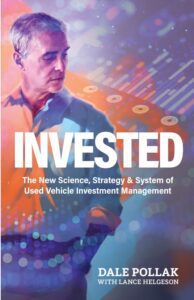I received the following note from a dealership manager that I thought I’d share:
I have a GM and a used car manager who are stuck in 1980 or Covid, take your pick. We are inverted in ProfitTime GPS. We continue to purchase an d sometimes appraise at high Cost to Market, intentionally assuming that someone will show up and pay the price. When they don’t, we start cutting the price. We either get lucky and sell the vehicle prior to all the reconditioning being assigned to the vehicle or, in many cases, it ages. Once it ages sufficiently to be a distraction, maybe 200 days, they will get aggressive about getting closer to the market and take the loss. They aren’t overly concerned about losses long term because they are covered by the grosses produced by new car sales and F&I. Predictably the used department is losing about $350,000 annually.
d sometimes appraise at high Cost to Market, intentionally assuming that someone will show up and pay the price. When they don’t, we start cutting the price. We either get lucky and sell the vehicle prior to all the reconditioning being assigned to the vehicle or, in many cases, it ages. Once it ages sufficiently to be a distraction, maybe 200 days, they will get aggressive about getting closer to the market and take the loss. They aren’t overly concerned about losses long term because they are covered by the grosses produced by new car sales and F&I. Predictably the used department is losing about $350,000 annually.
The error, according to the GM, is that we are not selling the vehicles fast enough. I suggest it’s not likely that vehicles will sell faster since no one will see the vehicle. It’s essentially hidden in the market due to their high market days supply and prices. Any search for these low ROI units is going to put them on page twenty and they won’t be seen. Nothing will persuade them to consider the Market Days Supply when initially pricing the inventory, or when acquiring inventory. And yes, they are all coming from the auction.
I suspect this sounds familiar to many dealers because I see varying shades of this situation in dealer inventories every day. I have great empathy for dealers in this situation because it’s their money, their investment in used vehicles and yet, the sub-optimal performance continues day after day, week after week, and year after year.
In this example, the manager’s well aware that changing the mindset of the dealership’s used vehicle management team won’t be easy. Why? Because they are stuck in the past, believing that every fresh car, no matter how right or wrong you own it, deserves a shot. They believe the calendar, or days in inventory, is the primary metric on which they judge a vehicle’s retail potential. They also don’t appear to understand, as the dealer rightly points out, that the cycle of marking up and holding onto cars until they’re discounted to meet the market is a sign of a highly efficient and transparent retail market. They don’t seem to get that today’s customers know better. There aren’t that many buyers out there anymore who you can convince to pay more than they should, especially if it’s a vehicle with high Market Days Supply.
The way I see it, the dealership’s used vehicle management team probably views themselves as astute “car guys” who know their market and their customers very well. I suspect they also probably regard themselves as individual success stories.
But here’s a fundamental reality of today’s market they consistently miss: That is, the rise of the Internet, and the increased market efficiency and transparency it has created, require more than traditional “car guy” skills to drive success today. We are now fully back into an environment where used vehicles are depreciating assets and achieving a positive outcome with every vehicle requires operating with more than a mere belief that you know what you’re doing.
Ultimately, today’s retail and wholesale market efficiency require a different mindset and skill set from the individuals who manage used vehicles. Yes, they need all the “car guy” smarts they’ve developed and honed over the years. But even more important, they need to develop their skills as prudent managers of investments.
Once they do, they’ll recognize that a troubled vehicle on Day 1, a unit that has a high Cost to Market, high Market Days Supply and low retail sales volume, is nothing more than a troubled investment on Day 1. They need to ask themselves what a prudent investor would do with an investment that screams “RISK!” from the moment they own it. The proper response, as we all know, is to get out of the investment as quickly as possible and deploy the capital to a more productive asset.
Given the ubiquity of the situation the dealer shared with me, it seems wise for everyone who’s got a stake in the outcome of a used vehicle department to take a moment and reflect on the following questions: Am I here to move metal or am I here to make money? Am I managing cars or capital? Am I a “car guy” with zero investment aptitude or a “car guy” who behaves, believes and thinks like a prudent investor?
If you’re honest about answering the questions, you’ll have the seeds to set the stage for a transformation of your used vehicle department that helps eliminate the annual losses and less-than-optimal outcomes many currently accept.
The post A Tale of Troubled Used Vehicle Department Performance and a Fix appeared first on Dale Pollak.





